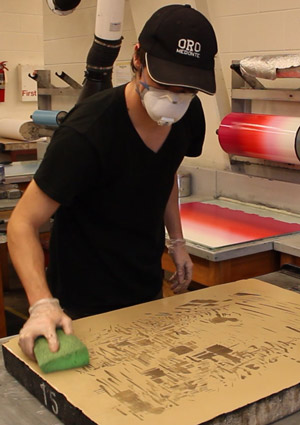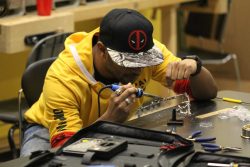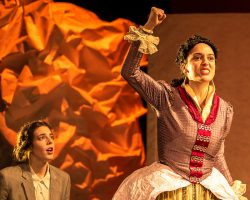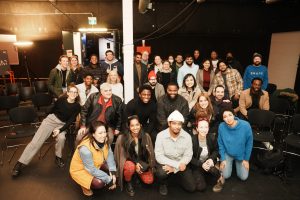UPDATE: Fall Planning in AMPD

AMPD is a leading example for the arts in Canada and beyond. Today we are faced with extraordinary challenges and opportunities. It is my hope that together with students, faculty, staff, alumni, community and industry partners, we can not only mitigate the negative effects of the current challenges, but also embrace opportunities for meaningful change that will help us survive and thrive in the days and years to come.
Last week, President Rhonda Lenton wrote to the York community about the University’s planning for the fall academic term. That message emphasized adherence to public health and safety and access to courses so that students can progress in their programs. The message also noted the potential for select experiential activities on campus. As explained in that communication, courses will clearly state whether on-campus activities may be required.
Because we do things a little differently in AMPD, I want to expand upon the President’s announcement and what it means for the various programs in the Arts, Media, Performance & Design.
As previously noted, all decisions and planning will be made according to the following principles:
- Safety and well-being of every person in AMPD and the broader communities in which they live and move (including, of course, public transportation)
- Equity and access for all students
- High quality educational experiences whether by online/remote delivery or in person
What does this mean for students, faculty and staff in AMPD?
First, it means that all decisions will be driven by the latest available information advice from Toronto Public Health and Public Health Ontario. Specifically, preparation for any on-campus activities will be accompanied by the following considerations and actions:

- available safety protections, including personal protection equipment (PPE) as advised by Public Health
- enhanced cleaning and sanitation in spaces: studios, labs and common spaces
- strict social distancing protocols
- minimal activity to avoid inadvertent contact in passageways and while entering and exiting AMPD and University spaces
In short, we will not compromise or risk the safety of any community member.
Second, we will continue to invest in excellent instruction via online/remote delivery. For over a decade, AMPD has established a record of excellence in eLearning courses. In response to COVID-19, faculty and staff have proved extraordinarily skilled in expanding these offerings by adapting courses to online and remote-learning environments. We will continue to support high quality e-Learning throughout the Faculty, including support for the community of practice in which instructors across departments and disciplines work together to ensure that all students receive the best of what the award-winning faculty at York can offer. We do this with particular attention to the needs of our international students as well as students coming to AMPD from outside the Toronto area and the Province. We understand that there are particular challenges for those who are studying from afar, so we are actively working to ensure that students everywhere have the opportunity for active participation in courses regardless of their location.
Third, within the health and safety parameters noted above, we will endeavour to create select opportunities for in-person activities. As deemed possible by Public Health authorities, some select on-campus, in-person activities may be offered within specific courses. To ensure equity, all on-campus activities will also have options for students who cannot or will not attend in person. Regardless of how students choose to participate in their classes, all students enrolled will be able to progress. Information on these elements will be clearly stated when fall courses are announced on June 5. (Note: enrolment will begin in June 8.)
Fourth, in support of research activities, for faculty and graduate student researchers, we will begin a careful phased return to research activities on campus this summer. Note: This policy applies to those activities that can only happen on campus and requests will be prioritized on this basis. This return will be cautious within the health and safety protocols and will be coordinated across the University. The emphasis on health and safety and the availability of PPE and other protections may mean that access to spaces happens more slowly than we might desire. We will all need to be patient as we return, so that we can ensure the safety and well-being of everyone.
What about performances, galleries, and other events?
Again, we defer to the Toronto and Provincial authorities and their statements on large gatherings for fall. At this time, we do not anticipate that live events will be possible, so I am grateful for the ingenuity of those who are creating so many exciting alternate opportunities. Relevant departments have shifted some of their usual group activities to the winter term and we are preparing for some events to happen via live-streaming or through alternate delivery without a live audience for the fall. If smaller gatherings become possible during this time, we may explore options of limited performances so long as other protocols – PPE, cleaning, etc. – can be safely implemented and no students will be disadvantaged.
What about courses that require specialized equipment?

Departments and programs are working hard to ensure that learning outcomes can be met via a wide range of alternatives, including “home kits” with necessary materials where possible as well as innovative strategies to meet learning outcomes within the limitations of current public health protocols and advice on social distancing.
For courses in which no alternative is available, we will endeavour to provide limited access to equipment for use or borrowing in so far as is possible within the earlier stated health guidelines and ensuring equity and access for all enrolled students.
Note: Many departments in AMPD have specific needs, challenges, and solutions. For questions specific to particular courses, spaces, and practices, please consult with your Department Chair. The Dean’s Office is working closely with Chairs to ensure that all programs have the needed information and resources for a successful fall.
What resources are available to help new students start in the fall?
For both continuing and new students, York has created several online resources for students, including the Student Guide to Moodle and AMPD’s Student Resources for e-Learning.
In addition, this year we will be launching a new Faculty-wide mentorship program to better support students at the beginning and through their respective programs.
CLICK HERE to learn about eLearning at York.
Should students in some programs just wait a year or so until things go back to “normal”?
This is a question that has been circulating quite a bit lately and it is certainly understandable. The changes wrought by COVID are significant and many of us are feeling overwhelmed by the scale and speed of these shifts. It is tempting to think that at some point everything will just go back to the way it was and that it may be best to wait for that moment.

However, it is unclear when “normal” will come and what it will look like. Already, we are seeing fundamental changes in the organizations and industries associated with AMPD’s disciplines and programs. As arts and design professions change, so too must education across our departments and programs. This next year offers us an extraordinary opportunity to learn at the beginning of what are likely to be lasting changes across fields, practices, and industries. The current circumstances have severely curtailed many of the activities that people hold dear, including all kinds of creative activities that delight, inspire and unite our culture. What we have seen throughout history is that with each fall comes a rise. As we learn to adapt to the current constraints, we will be better prepared to lead in arts education across Canada and to support our students in preparing to succeed in these dynamic fields. Those who engage over the next year will be best positioned for success in that future.
Even more importantly, this is a rare opportunity to guide these changes for the benefit of artists and their communities. The more we participate in collaborations across disciplines and professional communities this year, the more opportunity we have to ensure that long-term shifts create increased opportunity and access for diverse populations of students and their communities.
Finally, I believe strongly that the voices and perspectives of AMPD’s diverse student body are urgently needed within these current debates about the future of arts and culture in Canada and beyond. It cannot only be the established artists and organizations who set the priorities for the future. The diverse perspectives from emerging artists must be considered as well. By encouraging our students to begin and continue their work and by actively supporting them to grow and learn through these shifts, we will become not only a better Faculty but a stronger community.


